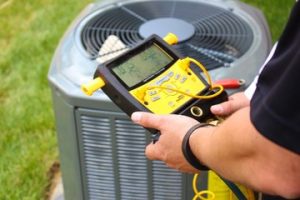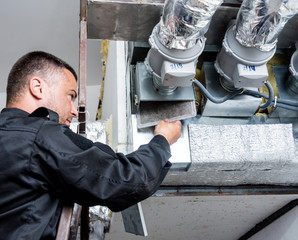The term “HVAC” covers all kinds of interrelated air control systems. Understanding the basics of these components can help you get a better grasp on your system’s role and function in your home or business.

It’s also important to know the ins and outs of HVAC Round Rock service plans. These proactively maintain your system and often reduce repair costs by catching minor issues before they become major ones.
Ventilation is a crucial component of HVAC, and it works to both heat and cool air. It also helps to reduce excess humidity. Without proper ventilation, you may notice a buildup of dirt and bacteria in your home or workplace. This can lead to discomfort and even health problems. The filtration system in HVAC systems is designed to remove these impurities and ensure that the air you breathe is clean and healthy.
When choosing an HVAC system, it’s important to do your research and find a unit that fits your needs. This includes assessing the climate conditions in your area, typical temperatures and humidity levels, and energy efficiency ratings. A trained contractor can help you choose the best system for your location and home.
An HVAC system consists of two main units, an indoor unit and an outdoor unit. The indoor unit contains the evaporator coil and air handler, while the outdoor unit contains the compressor and condenser coil. The ductwork runs throughout the house and connects the indoor and outdoor units.
The evaporator coils in an HVAC system contain the sub-cooled refrigerant, and air blows over these metal fins. As the air passes over these coils, it’s cooled and blown out into the room through the vents. The cold air is then distributed to the rest of the house.
During old-fashioned construction, most homes and office buildings had access to natural ventilation, which allowed fresh air to come in from the outdoors and stale air to be expelled. However, newer building designs tend to be more tightly-sealed, so mechanical ventilation is essential for optimal occupant comfort and safety.
Refrigerant
Refrigerant is the “lifeblood” of your HVAC system, as it’s responsible for transferring heat between inside and outside your home. It circulates through copper coils in your air conditioner’s evaporator and condenser, changing between liquid and gas states as it absorbs and releases heat. The cycle repeats itself over and over, cooling your home and moving hot air out the vents.
There are several different refrigerants used in air conditioning systems, each with its own unique set of properties. Most refrigerants are halocarbons, which are compounds made of carbon and chlorine, but there are also hydrocarbon refrigerants and even non-halocarbon options like hydrogen.
The type of refrigerant your system uses depends on the age and model of your unit. Chlorofluorocarbons such as R-22 (Freon) were once widely used in residential HVAC systems, but production and importation of this type of refrigerant has stopped due to ozone depletion concerns. New HVAC systems now use R-454B or other low GWP refrigerants, which are better for the environment and your energy bills.
When your air conditioning system needs a refrigerant recharge, it’s important to have a professional perform the service to prevent equipment damage and health risks. A qualified technician can inspect the system and perform a full diagnostic to locate any issues. They can then repair the refrigerant leak and recharge the system to its manufacturer’s specifications.
Many homeowners assume that they can simply refill their AC with refrigerant on their own, but this is a dangerous task that should be left to professionals. Recharging refrigerant incorrectly can lead to permanent equipment damage and environmental concerns. If your refrigerant is running low, reach out to Burgeson’s for reliable HVAC service.
Furnace
Furnaces are the heating element in HVAC, and they’re responsible for generating and distributing warm air throughout a home or office. They use natural gas, propane, or electricity to create intense heat in a safe container that can then be distributed through the ventilation system.
A furnace starts by combining fuel with oxygen, combusting it to produce thermal energy and heat. The heat is then transferred to a heated exchanger, which warms the incoming air before it’s pushed into the indoor environment. The temperature is controlled by the thermostat, which signals the furnace to activate based on its programmed preferences.
The blower fan then pushes the warm air into the rooms in the building through ductwork. A filter keeps dust and debris out of the vents, while a flue and vent pipes expel the combustion gases outside.
While a furnace can operate by itself, it’s often paired with a heat pump or air conditioner to offer complete climate control. Unlike furnaces, heat pumps and air conditioners don’t need a dedicated cooling source to work.
Many homeowners choose to install a furnace with an air conditioner because they can save money on energy bills by relying on one unit to provide both heating and cooling. In some regions, the cost of natural gas is less than that of electricity, making a gas furnace a smart choice.
A furnace’s energy efficiency rating is determined by its AFUE (Annual Fuel Utilization Efficiency) rating, which indicates how much of the fuel it uses to create heat. The higher the AFUE, the more efficient the furnace is. Furnaces can also be paired with an air handler, which doesn’t have its own energy efficiency rating but is usually measured by the SEER (Seasonal Energy Efficiency Ratio) of the heat pump or air conditioner with which it’s paired.
Air Handler
The air handler is the indoor component of your HVAC system. It has an evaporator coil that cools the air, and a blower fan that circulates the conditioned air throughout your home. The air handler also contains a drain pan that collects condensation from the cooling coils. The air handler can be powered by electricity or natural gas, depending on the availability of each in your area.
An air handler is basically a bigger version of the furnace inside your home. It may look like a metal box that houses the evaporator coil, a blower fan and other components. It can be sized for either residential or commercial use and can be powered by electricity, gas, steam, water, or solar energy. A smaller air handler usually only has an evaporator coil, air filter and blower fan. These units are often used in homes that already have baseboard heat, but want to install ductless air conditioning.
In heating mode, the air handler uses electric heat strips (similar to those in a toaster) that warm up the air. The blower then circulates the air over the hot elements to warm it up before it is blown into your home. The air handler can also be fitted with an electric heater package, which adds heat to the circulation of your ductwork.
The air handler has an air filter that removes particulates from the circulating air. This helps improve your home’s indoor air quality, and keeps dust, dirt, and other contaminants from clogging the evaporator coil. It can also contain a humidifier or dehumidifier to regulate humidity levels. Finally, it may have a frost coil to prevent ice from forming on the coil in extremely cold climates.
Thermostat
The thermostat is the brain of your heating and cooling system, working constantly to keep the space at a comfortable temperature. In its simplest form, it senses the room temperature and turns your HVAC system on or off to bring the room to a specified “set point.”
Modern digital thermostats display your settings and current temperature on a screen and offer buttons or touchscreens for easy control. These thermostats help you heat and cool your home more efficiently, reducing energy usage year-round.
Regardless of the type of thermostat you have, it relies on a complex network of sensors to monitor and adjust the interior climate. These systems also feature controls to optimize the start and stop of heating and cooling. The sensors measure conditions like air temperature, humidity, indoor carbon dioxide, and more. The information is sent to the processing unit, which then decides when and how to activate your HVAC system.
If you have a programmable thermostat, you can set the temperature for the day and/or time of the week. Then, the system will automatically adjust the temperature to match your schedule, saving you time and energy.
Other advanced thermostats are designed to optimize your HVAC system’s operation based on the building’s load calculation, which considers occupants, solar loads on the structure, plug load (all the appliances that use electricity), and more. These thermostats combine your setting with other input devices and logic to provide even more energy savings.
